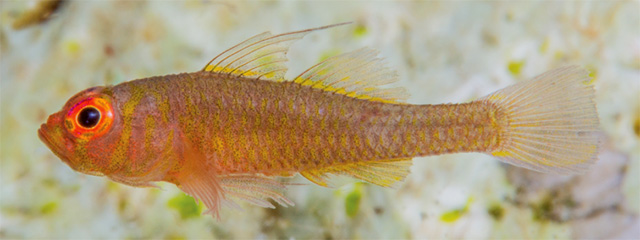| Gobiidae (Gobies), subfamily: Gobiinae |
| 2.08 cm SL (female) |
|
reef-associated; marine; depth range 8 - 50 m |
| Western Central Pacific: Papua New Guinea, Timor Leste and Philippines. |
|
Dorsal spines (total): 7-7; Dorsal soft rays (total): 8-8; Anal spines: 1-1; Anal soft rays: 8-8. This species is distinguished by the following characters: scales in the predorsal midline; no scales on the cheek or opercle; elongated second spine of the first dorsal fin reaching to the bases of the 2nd-8th second dorsal-fin rays when adpressed; unbranched pectoral-fin rays; fifth pelvic-fin ray branched with a full basal membrane; when fresh, yellow bars on the head and vertically elongate yellow spots on brown body (Ref. 119765). |
| This species appears to be a rare species, with seven specimens collected mostly between 10-16 m. Found living under large pieces of dead foliose coral rubble on a sandy bottom subject to moderate currents and wave action. It is apparently a solitary species, only a single specimen collected from each piece of rubble examined (Ref. 119765). |
|
Least Concern (LC); Date assessed: 07 September 2021 Ref. (130435)
|
| harmless |
Source and more info: www.fishbase.org. For personal, classroom, and other internal use only. Not for publication.

